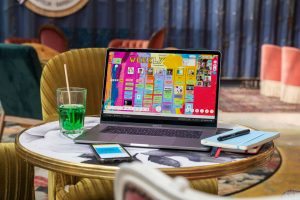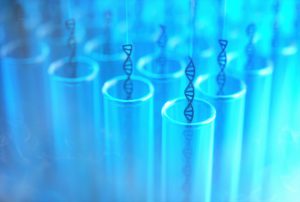When not confined to a container, liquids will splatter, dribble, and ooze. They shape-shift into their surroundings as puddles and streams, largely beyond human control.
Lauren Zarzar is trying to make more obedient liquids. Zarzar, a materials scientist at Pennsylvania State University, designs liquids that she can tame—fluids that move or change shape on command. That could mean a tube of water that retains its shape inside a second fluid, or a droplet that separates into two different oils when triggered by light. At their most ambitious, these liquids could even become electronic circuit components. Researchers have already made all-liquid wires and antennas.
Zarzar is working with tiny droplets about a tenth of a millimeter in size. These droplets consist of two types of oil, one encased in the other, like caramel in chocolate. When she changes the temperature of the droplet’s surroundings, she can make the droplet turn inside out.
They’re not sure what they want to do with the droplets, but Zarzar imagines that you could use them to trigger chemical reactions: Place a catalyst inside some droplets, dump them into a container of reactants, and when you want the reaction to begin just flip the droplets inside out. Or, she thinks they could be fashioned into liquid lenses for a microscopic camera that change their focus by morphing in real time.
But the applications don’t capture the creative shift now underway in how materials scientists consider liquids. “When people think of a liquid, they think of a chemical in a flask that doesn’t do anything,” says Zarzar. “We’re thinking about liquid as a material, about how to harness its structure and adaptability.”
One goal is to develop liquids that retain a customized shape without containers or molds. To do this, materials scientist Tom Russell and his colleagues at Lawrence Berkeley National Laboratory have modified a 3D printer to make a variety of all-liquid structures. Using a syringe attached to the printer, they can inject spirals of water into a surrounding body of water. The spirals keep their shape because the printer injects nanoparticles in with it, which form an extremely thin membrane around the structure. It’s almost like blowing smoke rings, except in liquid. “We can print a tube of liquid in another,” says Russell.
Using this printer, his colleague Brett Helms, a chemist, has created a liquid with an internal vessel structure. The liquid sits on a microscope slide like a small puddle with a canal running through it, propped up by a nanoparticle membrane.
The blue liquid, which contains nanoparticles, travels through a second liquid. The nanoparticles form a membrane to keep the two fluids from mixing.
To make this structured liquid, Helms and his collaborators first coated the microscope slide in a pattern of a water-repelling plastic, which determines the shape of the canal. Then, they use the 3D printer to deposit two liquids on the slide, each containing a different type of nanoparticle. Where the nanoparticles meet, they form a membrane, allowing a stable channel to form inside the liquid. They want to use these all-liquid structures to study how chemical reactions proceed, says Helms. For example, by changing the geometry of the channel, they can control how quickly chemical reactions occur, potentially letting them slow down the process to observe the dynamics of molecules in more detail.
The nanoparticles stabilize the vessel structure using an effect also found in salad dressing. When mixing a vinaigrette, you create droplets of vinegar suspended in oil. Over time, the vinegar droplets coalesce and separate out from the oil, but if you add particles like black pepper to the dressing, you’ll find the vinegar droplets stay suspended longer. “All the herbs go to the interface of the oil and vinegar, and they stabilize the droplets,” says Russell. “In a sense, that’s what we’re doing.”
Researchers also exploit the same chemical principles that make soap bubbles possible. To stretch a water droplet into a bubble, you add soap. The soap makes water less likely to coalesce into a drop, also known as lowering its surface tension. Similarly, researchers add soap-like particles known as surfactants to droplets to make them malleable. “We’re making liquids into shapes normally not allowed by gravity and surface tension,” says Michael Dickey, a chemical engineer at North Carolina State University.
These nanoparticle-infused droplets are magnetized, so that when placed in a magnetic field, they twirl in unison.
Dickey works with liquid metals—alloys of gallium and indium that flow at room temperature like mercury, but without the toxicity. To shape these liquids, he places them in a salt solution and applies a voltage to the metal. The voltage triggers a chemical reaction to produce soaplike molecules that change the metal’s surface tension.
He thinks these metals could be useful as components in flexible, wearable electronics. In addition, liquid electronics can self-heal: Cut a liquid wire, and you can make the two ends flow toward each other to reattach.
Dickey’s team has made a pair of headphones in which a conventional headphone jack is affixed to liquid gallium indium wires. “You don’t need solder,” says Dickey. “You just touch the two things together, and you have pretty good electrical contact.” These headphone cords sit inside a plastic casing to keep their shape, but they portend a future of soft, stretchy gadgets. Dickey keeps the headphones in his office, where he likes to show them off to visitors—stretching the liquid wires back and forth like a rubber band without noticeably changing the sound quality or audio volume.
Developing obedient liquids could also help answer fundamental questions about science, says Zarzar. For example, she points out that living things are mostly composed of liquids structured with membranes. The adaptable liquids and membranes that she works with are “almost a prototype to life,” she says. They don’t use biological liquids and the techniques aren’t precise enough yet, but she wants to work toward creating liquids that mimic lifelike materials. Constructing cell-like membranes and shape-shifting liquids could give them a glimpse into the instruction manual of nature’s 3D printer.
More Great WIRED Stories
- xkcd’s Randall Munroe on how to mail a package (from space)
- Why “zero day” Android hacking now costs more than iOS attacks
- Free coding school! (But you’ll pay for it later)
- This DIY implant lets you stream movies from inside your leg
- I replaced my oven with a waffle maker and you should, too
- 👁 How do machines learn? Plus, read the latest news on artificial intelligence
- 🏃🏽♀️ Want the best tools to get healthy? Check out our Gear team’s picks for the best fitness trackers, running gear (including shoes and socks), and best headphones.



